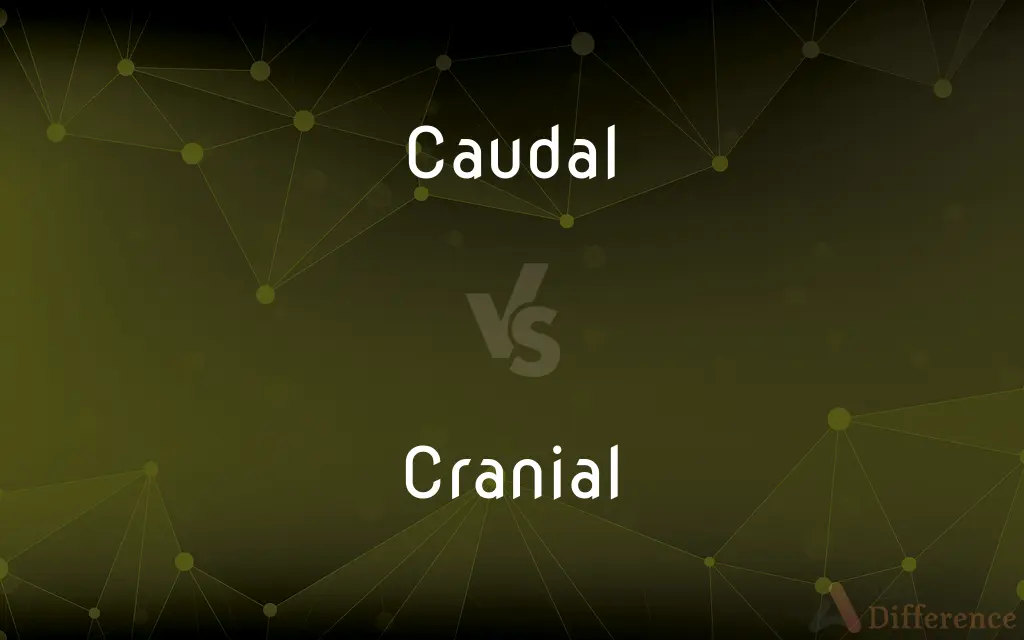Caudal vs. Cranial — What's the Difference?
By Maham Liaqat & Fiza Rafique — Updated on April 16, 2024
Caudal pertains to the tail or posterior part of the body in many animals, indicating direction toward the rear; cranial relates to the skull or head, referring to direction toward the front or top.

Difference Between Caudal and Cranial
Table of Contents
ADVERTISEMENT
Key Differences
Caudal is a term used in anatomy to describe features or directions towards the tail end of the body in animals, commonly applied in medical and biological contexts. In contrast, cranial refers to structures and directions towards the head or skull, often used to describe the orientation of anatomical structures.
When describing the position of organs or body parts, caudal indicates a location nearer to the tail or lower end of the body, such as the caudal end of the spine. On the other hand, cranial points towards the head, as in referring to the cranial part of the spinal column near the skull.
In the context of movement, a caudal movement means moving towards the tail end, which is useful in surgical or diagnostic procedures for clarity. Whereas, cranial movement refers to moving towards the head, providing clear directional guidance in medical settings.
The usage of caudal is particularly prevalent in the study of vertebrates, where distinguishing between the head and tail ends is necessary for anatomical and functional descriptions. Meanwhile, cranial is extensively used in neurology and head-related medical studies to specify locations relative to other parts of the skull and brain.
In evolutionary biology, caudal traits refer to those that are located towards or adapted for the posterior part of the body. Conversely, cranial traits often involve adaptations related to the sensory organs on the head, such as eyes and ears, crucial for the survival and interaction of the organism.
ADVERTISEMENT
Comparison Chart
Definition
Pertaining to the tail or posterior part.
Pertaining to the skull or head.
Anatomical Reference
Towards the rear or tail end of the body.
Towards the front or head of the body.
Usage in Movement
Moving towards the lower body or tail.
Moving towards the upper body or head.
Common Usage in Biology
Describes posterior features or positions.
Describes anterior features or positions.
Importance in Medicine
Used in referencing lower body parts.
Crucial for describing head-oriented details.
Compare with Definitions
Caudal
Relating to the tail or posterior part of the body.
The caudal fin of the shark provides propulsion.
Cranial
Pertaining to the cranium or skull.
The study focused on cranial capacity in different human populations.
Caudal
In evolutionary terms, indicative of features at or near the tail of an organism.
Caudal appendages in some lizards aid in balance.
Cranial
Directed toward the head.
Cranial migration of cells is critical during development.
Caudal
In procedural terms, moving towards the tail during an operation.
The surgeon made a caudal incision below the kidney.
Cranial
Relating to the skull or head of a vertebrate.
Cranial nerves originate in the brain and serve the head and neck.
Caudal
Directed toward the tail or rear.
The injury was located at the caudal end of the vertebral column.
Cranial
Used to describe the anterior or upper position of body structures.
Cranial to the shoulders are the neck and head.
Caudal
Used to describe the position of a structure relative to other structures in the tailward direction.
The caudal thoracic vertebrae are toward the rear.
Cranial
In medical terms, involving movement or access towards the head.
Cranial access was necessary for the brain surgery.
Caudal
Of, at, or near the tail or hind parts; posterior
The caudal fin of a fish.
Cranial
Of or relating to the skull or cranium.
Caudal
Situated beneath or on the underside; inferior.
Cranial
(anatomy) Of or relating to the cranium, or to the skull.
Caudal
Similar to a tail in form or function.
Cranial
(anatomy) cephalic.
Caudal
(zoology) Pertaining to the tail or posterior or hind part of a body.
Cranial
Of or pertaining to the cranium.
Caudal
Toward the tail end (hind end) of the body; in bipeds such as humans, this direction corresponds to inferior.
Cranial
Of or relating to the cranium which encloses the brain;
Cranial pressure
Caudal
A caudal vertebra.
Caudal
Of the nature of, or pertaining to, a tail; having a tail-like appendage.
The male widow-bird, remarkable for his caudal plumes.
Caudal
Constituting or relating to a tail;
Caudal appendage
Caudal
Resembling a tail
Caudal
(of quadrupeds) situated in or directed toward the part of the body from which the tail arises;
Caudal fins
The caudal end of the body
Caudal
Toward the posterior end of the body
Common Curiosities
Can caudal and cranial be used interchangeably with anterior and posterior?
No, caudal and cranial are specifically used for directions toward the tail and head, respectively, while anterior and posterior refer to the front and back sides.
What does caudal mean in medical terms?
In medical terms, caudal refers to positions or directions towards the tail or posterior part of the body.
What does cranial refer to?
Cranial pertains to anything related to the skull or head, particularly in anatomical positioning.
Are caudal and cranial only used in vertebrates?
Yes, these terms are primarily used in vertebrate anatomy to describe positions relative to the spine.
What are typical uses of the term caudal in veterinary medicine?
In veterinary medicine, caudal is often used to describe injections, surgical sites, or anatomical descriptions toward the animal's tail.
How do cranial features differ in various animals?
Cranial features vary widely, often housing critical sensory organs like eyes and ears, adapted to different environmental needs.
What evolutionary significance do caudal features have?
Caudal features can relate to locomotion, balance, and defense mechanisms in various animals.
Is the term caudal used in human anatomy?
Yes, caudal is used in human anatomy to describe positions or directions towards the lower part of the body.
How is cranial used in neurological studies?
In neurological studies, cranial often refers to aspects related to the brain and cranial nerves, crucial for understanding brain function.
Why is understanding cranial anatomy important for surgeons?
Understanding cranial anatomy is essential for surgeons, especially neurosurgeons, to safely and effectively perform surgeries involving the brain and related structures.
Share Your Discovery

Previous Comparison
Laugh vs. Cackle
Next Comparison
Exegesis vs. HermeneuticsAuthor Spotlight
Written by
Maham LiaqatCo-written by
Fiza RafiqueFiza Rafique is a skilled content writer at AskDifference.com, where she meticulously refines and enhances written pieces. Drawing from her vast editorial expertise, Fiza ensures clarity, accuracy, and precision in every article. Passionate about language, she continually seeks to elevate the quality of content for readers worldwide.














































